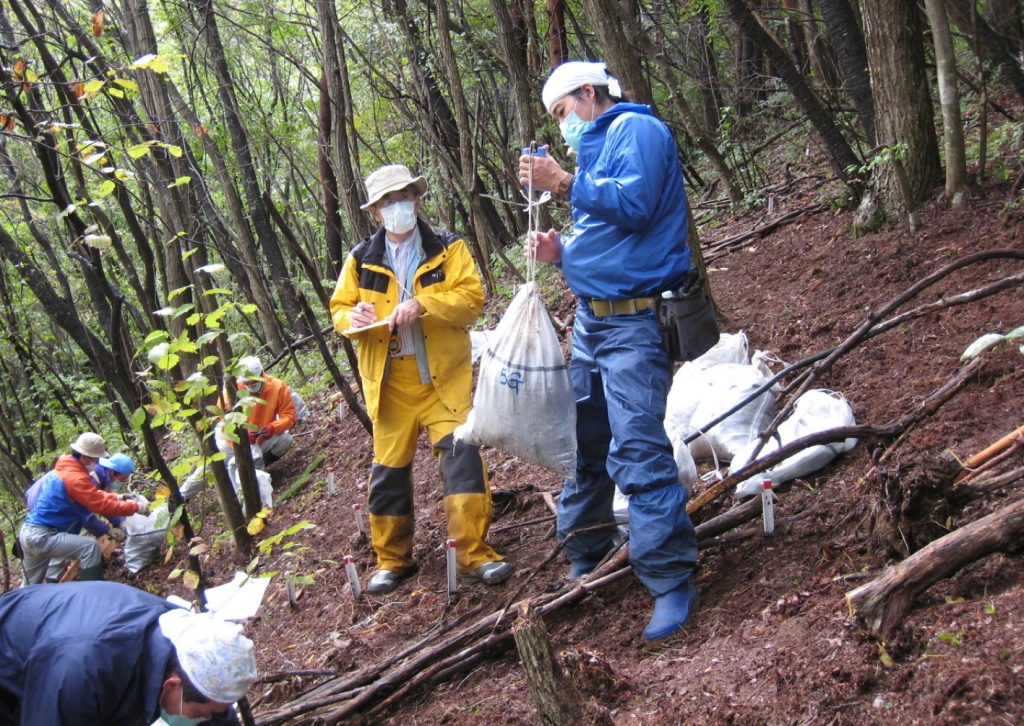Congress Spotlight #72 – Radioactive Contamination and Forests: Learning Lessons from Chernobyl and Fukushima
Forests, except in the most severe cases, are quite resilient to radioactive contamination and will continue functioning normally.
That is one of the surprising takeaways from the nuclear accidents in Chernobyl and Fukushima.

Photo: FFPRI
It may be necessary to prevent people from entering heavily contaminated forests for many years and the edible forest products from such areas cannot be used. But there are no reports of loss or damage to forest ecosystem services such as watershed protection, biodiversity and carbon storage.
At the IUFRO World Congress in Brazil this fall, scientific sessions will examine radioactive contamination in forests and the consequences for both forestry and affected communities.
Dr. Satoru Miura, Director of Japan’s Center for Forest Restoration and Radioecology, Forestry and Forest Products Research Institute, is the chair of coordinators at a session entitled: Current understanding and future challenges for forest research after the two nuclear accidents of Chernobyl and Fukushima.
When the Fukushima nuclear accident occurred in 2011, “we did have the advantage of the lessons of Chernobyl,” said Dr. Miura. Japanese scientists were able to use a large number of scientific papers and reports from the Chernobyl nuclear event and its consequences to inform their decisions and actions regarding Fukushima.
For the forest scientists that meant the ability to begin monitoring the forests and the concentration of radioactivity in forest products immediately. Valuable initial data were gathered and, as the 10-year anniversary of Fukushima approaches, a comprehensive overview of what has been learned is being compiled.
Dr. Miura notes that, “after the Chernobyl accident it was quickly realized that ‘radioecology’ is a multidisciplinary field that needs the complementary skills of physicists, chemists, biologists, mathematicians, engineers, social scientists, psychologists and others to fully understand the impacts of radioactive contamination on forests and other ecosystems.”
In Japan, cross-disciplinary workshops have been held that allowed researchers from a number of disciplines to exchange opinions on what could be done to manage the consequences of Fukushima.
The underlying principle for the management of contaminated forests is that it must be “realistic and pragmatic,” he said. Cost-benefit analyses and accurate modelling of future contamination, among other things, have been suggested as indispensable parts of the process.
Options to mitigate negative impacts range from abandoning timber crops, delaying or bringing forward timber harvesting, applying fertilizers such as lime and potash from the air to reduce the uptake of radiocaesium by trees, restricting game hunting and wild food gathering as well as restricting public access.
In both Chernobyl and Fukushima, some chromosomal abnormalities of wildlife such as field mice and some structural abnormalities of coniferous tree species have been reported, but there have been no reports of fatal effects on wildlife.
“The effects of radioactive contamination vary widely, depending on the type and level of the accident, the tree type, soil type, topography, socio-economic conditions and local and national responses,” he said.
Chernobyl’s “Red Forest” – a plantation about 2-3 km west of the Chernobyl reactor – is the only documented case of organisms in forests being killed by radiation.
There, in a narrow, 200-300 metre area of destruction, Scots pines died within weeks of receiving extremely high radiation doses. Birch species have since quickly colonized the open spaces left by the dead pines and trees immediately outside the “lethal dose” zone continue to grow with no obvious abnormalities.
In fact, in the case of the “Red Forest” and surrounding areas there has been inward migration of wildlife – boar, moose, bear, wolf and European bison are commonly seen there. This has been attributed primarily to the absence of people after the disaster. Published evidence of the effects – or lack of effects – of radiation exposure in these animals has been contradictory.
Dr. Miura said the Brazil Congress offers a timely opportunity to bring together specialists in forest radioecology, especially those working in the Fukushima area, who have made some major advances in our understanding of the short- to medium-term impacts of radiocaesium contamination of forests after a severe nuclear accident.
As a cautionary note, he added: “There are more than 400 nuclear reactors in the world. So, everyone should have an awareness of the potential for accidents. We must develop the science and technology to respond rapidly and effectively to limit and mitigate the effects of contamination.
“And, speaking as a forest scientist, we must learn in ways that allow us to maintain the sustainable management of forests,” Dr. Miura said. “These sessions will give us some indication of how far we have come in terms of understanding and should also give an idea of where we have to go.”
See you at the IUFRO 2019 World Congress!
Visit http://iufro2019.com/ * Look out for #IUFRO2019 on Twitter and XXV IUFRO World Congress 2019 on Facebook
View all IUFRO Spotlights at http://www.iufro.org/media/iufro-spotlights/

Leave a Reply